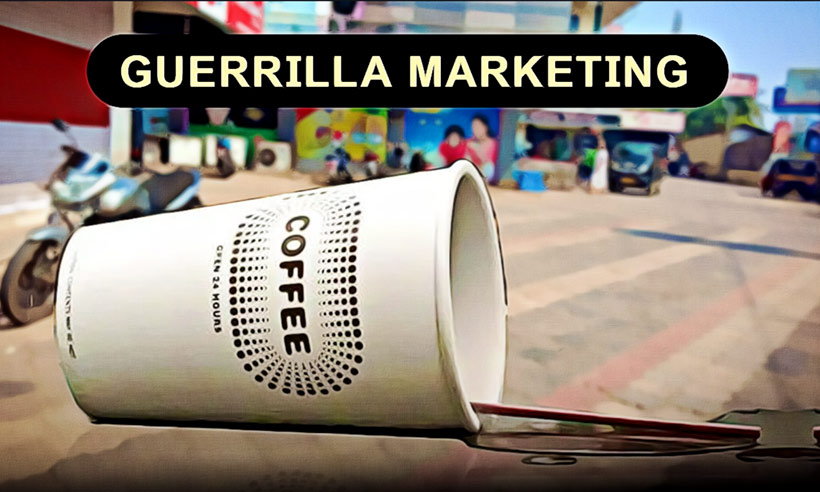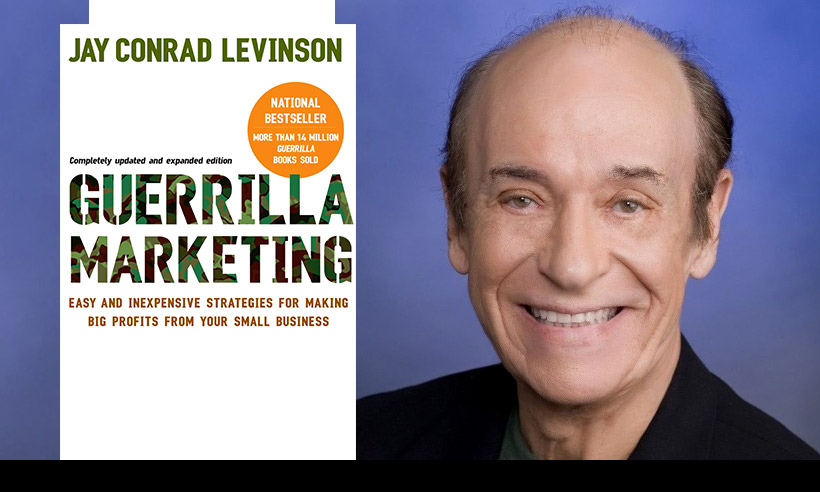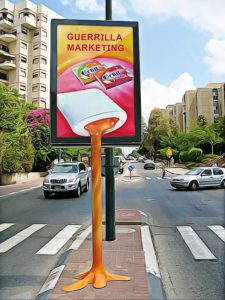A Complete Guide to Guerrilla Marketing With Finest Examples


Throughout the year, every month, every week, and every moment, the companies bombarded us with plenty of information, promotions, and advertising. Some advertising campaigns like Guerrilla marketing genuinely make sense and can grasp the customer’s attention. While some simply look unpleasant and unattractive. In this age of cryptocurrencies and transformational technologies, every small or brand big brand is scratching its surface to present something extraordinary to its potential customers. This could be the reason why total advertising expenditure in North America alone has surpassed over 296.4 billion in 2021. If you think that your marketing tactic is mainstream and mundane, then guerrilla marketing can break that mold.
In this thorough blog, we will discuss almost everything about guerrilla marketing and will explore some finest examples that will leave you in deep shock.
Table of Contents
Guerrilla Marketing: The History


The term “GUERRILLA MARKETING” was first coined by the American Business Writer named Jay Conrad Levinson. He was the person that has introduced us to this term in his book “Guerrilla Marketing: Secrets for Making Big Profits from Your Small Business” in 1984. Guerrilla marketing was originally inspired by guerrilla warfare. In general, guerrilla warfare is the form of irregular warfare that usually relates to small tactic strategies used mostly by armed civilians. It was majorly intended to shock and then later defeat the warfare enemies using irregular tactics such as ambushes, raids, and hit-and-run strategies.
The main purpose of guerrilla marketing was to attract the masses and to further gain optimal results. Jay Conrads’ examined the success of guerilla marketing and started adapting to the other forms of marketing campaigns alike.
In the early 1980s, the United States along with the small business has faced a major crisis due to a lack of resources and thoughtful ideas. This has led them to find some unconventional ways to outperform the corporate giants and compete with them at the same levels. But without exceeding their budget. As Levinson cited in his book that small business owners too can leverage the power of guerilla marketing with limited resources, it has given small businesses the perfect opportunity to shift the attention of the customers towards their brand by creating strong guerrilla marketing strategies.
Instead of using conventional tactics, the small business has started incorporating more creative, refreshing, and modern ideas that could go noticed and not unnoticed by the audience.
Today, guerrilla marketing has become a thing and allows every brand to make the most of guerrilla marketing for the customers at a memorable level.
Definition of Guerrilla Marketing


In the modern marketing world, Guerrilla marketing acts as the unconventional form of marketing or tactic to promote products or services, raise brand awareness and impact a large audience with a minimum budget. With the help of this form of inbound marketing, many companies use wit, humor, sarcasm, and even bring social awareness by placing guerrilla marketing differently.
In the beginning, the concept of guerrilla marketing was for small businesses only. But big brands have also started infusing guerrilla marketing techniques because:
- It attracts millions of customers and not just individuals.
- It organically boosts sales
- The use of more personal interaction with the audience increases the brand’s loyalty
- It amplifies the messages more positively
- It created bold, memorable, and bold emotional connections with prospective customers.
In simple words, Guerrilla marketing is all about using the campaigns professionally whether online, offline, or a mix of both to share information with some sort of emotional appeal.
Types of Guerrilla Marketing


Since the inception of guerrilla marketing in the 1980s, the concept has majorly grown from extraordinary to one of the most flexible tools in the arsenal of every business team. One of the main reasons behind this humongous success is- it’s adaptable to nature, illustrative with a diverse approach, and in tune with the digital era that we are witnessing today.
With this in mind, we have listed below different types of guerrilla marketing that could work in your favor:
Ambient Marketing
Ambient marketing is perhaps the most approachable form of marketing that works similarly to a traditional offline advertisement. Just like television or magazine, the main attention-grabbing object or image is intentionally placed in the highly visible area. The main purpose of ambient marketing is to make an ever-lasting impact on the viewers while making good use of the environment of the product, brand, or company as the main highlight.
A notable brand like McDonald’s has utilized this approach over the years consistently.
Ambush Marketing
It is another effective strategy that companies use while taking advantage of an event to promote products or services. The marketers mostly use “ambush” to drive attention towards their brand and steal the spotlight from their contemporaries.
The American multinational corporation i.e; Nike used ambush marketing in the 2010 FIFA world cup to offer a memorable experience to the audience.
Undercover or Stealth Marketing
As the name suggests, undercover marketing is all about keeping the sale pitch hidden yet effective without knowing prospective customers. The idea is to keep the marketing strategy subtle and hidden just to create a buzz about the specific product.
For instance, Sony Ericsson did an unusual marketing tactic using ambush marketing. The company hired actors who played as tourists. They were asked to approach strangers on the streets to click their photos or images using a Sony Ericsson brand new mobile phone only.
Viral or Buzz Marketing
In this 21st century, viral marketing has become the biggest phenomenon. Viral marketing is the practice or approaches professionally designed for others to share your products or services with you. In other words, Viral marketing is the kind of promotional strategy that aims to convey your business message with the help of a reliable audience.
Using viral marketing, the brand can target and further reach millions of global customers through thought-provoking videos, memes, or images.
Grassroots Marketing
Grassroot is a little tedious and needs more effort from the others. The marketing strategies are crafted in a way to target the high niche audience and drive their interest in the brand.
One of the finest examples of grassroots marketing is the ALS bucket challenge. You must have seen millions of people from across the world including influential celebrities. They were seen pouring a bucket of ice water on their heads and tagged others on social media to do the same.
Street Marketing
In street marketing, the brands make smart use of streets and other public areas using over-the-top marketing strategies. The main goal of street marketing is not only to promote the brand but to create a long-lasting impression using an indifferent approach to an idea.
Flashmobs. roadshows and innovatively distributing products is one of the ways of making street marketing work in your favor.
Reverse Graffiti Strategy
The reverse graffiti strategy is slightly different from street marketing. The marketers remove the dirt, dust from the streets to create the reverse graffiti strategy. They treat streets like a canvas and use their vivid imagination to make them look more appealing and interesting at the same time.
Experiential Marketing
Experimental marketing provides the customers with a memorable experience by creating the situation they can interact with. It also allows the customers to connect with the brand smartly.
The “Flash Mob” is a good example of experimental marketing that looks more realistic and effective at the same time.
Astroturfing
Astroturfing or astroturf marketing is considered one of the controversial or risky marketing techniques only if the customers find it unauthentic. Unlike any other type of marketing, it creates an unnecessary hype or artificial appearance by using fake endorsements or testimonials.
Some examples of astroturfing marketing include companies hiring bloggers to create a product review that is unbiased or using multiple paid social media account to promote one’s products.
5 Powerful Examples of Guerrilla Marketing to Level Up Your New or Existing Marketing Campaigns


When the specific brand or company uses creativity to entice the customers, this is when guerrilla marketing happens. Many multimillionaire companies have already taken advantage of this special extra force to offer the customers something sensational they have never seen or felt before.
That being said, here are some of the dominant brands that have smartly turned their marketing campaigns into success:
-
McDonald’s
This brand once painted the zebra crossing lines as french fries coming out of the package to create a guerrilla marketing look more realistic.
-
Frontline
Frontline has used the brainstorm idea by putting an oversized picture of an itching dog in the lobby door of the mall. It allowed people to walk through the building to represent the bugs if seen from the above floors.
-
Kitkat
The deliciously famous brand has smartly transformed the urban benches of the commonplace into the shape of a chocolate bar.
-
Coca-Cola
Coca-Cola has painted the bus stops into an open refrigerator. It is meant to give a sense of soothing effect to the customers waiting for the bus.
-
Discovery Channel
To make guerrilla marketing worthwhile, this brand placed bitten boards instead of regular ones along the beaches to represent upcoming shark week.
Along with this, many prominent brands like IKEA, National Geographic, Mr. Clean, Tyskie, Unicef, Duracell, etc. have understood the concept of guerilla marketing thoroughly. They have used them wisely to remind users about their existence in the market.
When and When Not to Use Guerrilla Marketing Strategies
Guerrilla marketing is one of a kind strategy that uses out of box solutions. Also, it uses a dash of surprise factor that can evoke a sense of emotions in people’s minds or hearts. However, you need to keep some important things in mind to get the most from the guerrilla marketing campaigns.
When to Use Guerrilla Marketing
- For getting media and peoples attention
- To make a positive yet memorable experience
- For creating a deep connection with the audience emotionally
When Not to Use Guerrilla Marketing
- For crafting fake stunts or promotion
- For not to disrespect, provoke or gain unnecessary sympathy from the public
- Not to target some community, caste, creed, or religion
Is Gueriila Markteing Illegal?
The shocking nature of most guerrilla marketing campaigns and the recurring news about the brands being penalized for them make people think that guerrilla marketing is illegal. However, the fact remains untrue.
Many big or small corporations sometimes come into conflict with the law. The reason being of not using their guerrilla marketing campaigns professionally and legally; For instance, a brand like Coca-Cola was heavily fined many years ago for putting up branded graffiti in historic New Orleans neighborhoods. Unfortunately, the same turned out to be a disaster and end up not getting approval from concerned or local authorities.
However, you can obey the law and still be creative and provocative with your advertising campaigns. To avoid problems, consult an attorney. They help you review restrictions, get approval, etc.
The Secret Behind Guerrilla Marketing
Guerrilla marketing tactics surprise your audience, make them interact with your brand, and stir emotions, sometimes even indignation.
No matter what you must make good use of every guerilla marketing strategy professionally, ethically, and thoughtfully. To make a greater yet peaceful effect on the targeted audience, take advantage of guerilla marketing wisely.






